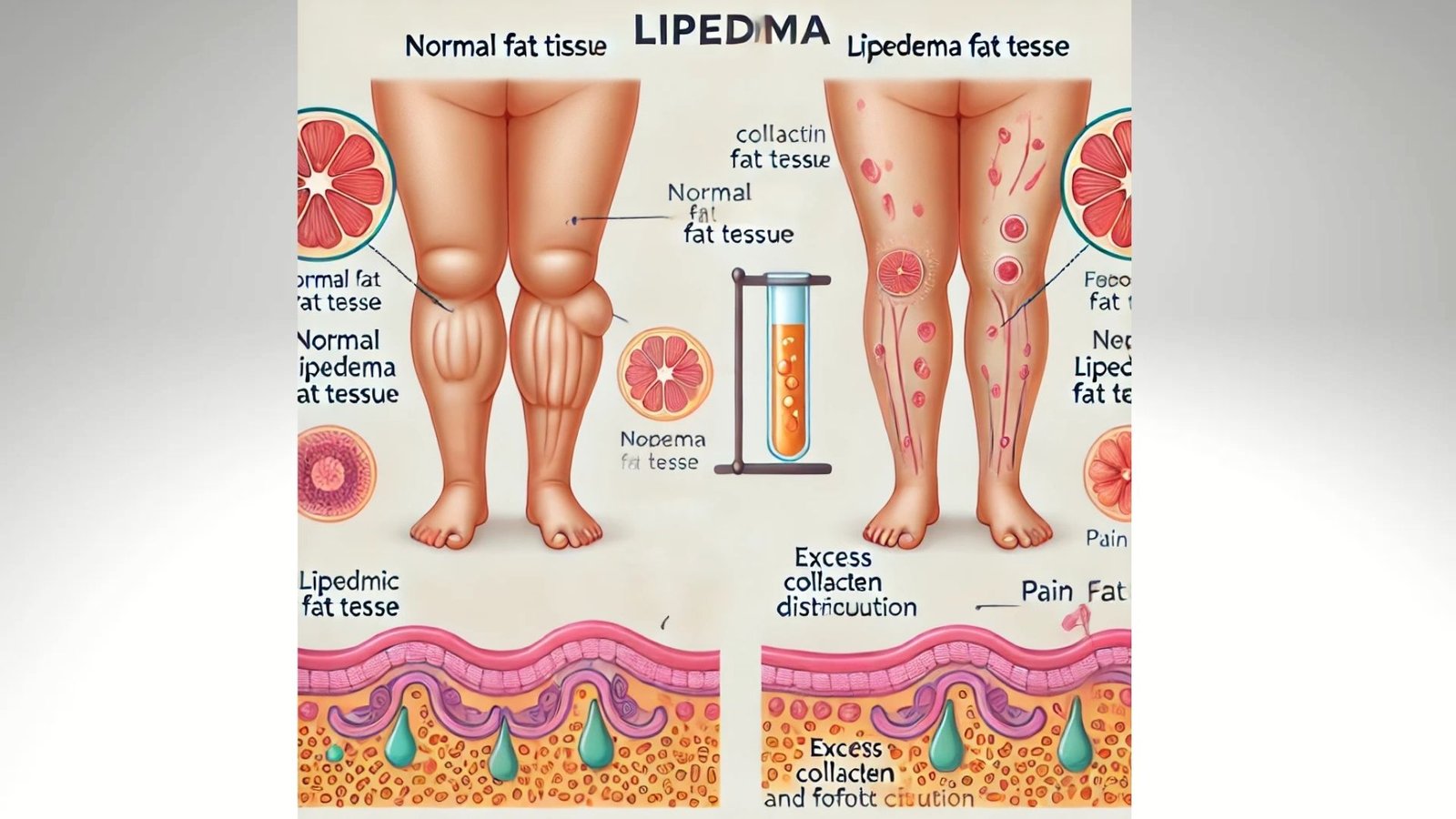Introduction – What is Lipedema and Why Should You Care?
Ever felt like your lower body just won’t slim down no matter what you do? Maybe your legs feel heavy, swollen, and even painful at times? If so, you might be dealing with lipedema, a condition that affects millions of women worldwide. And no, it’s not just about weight gain or stubborn fat – it’s actually a disorder of connective tissue and fat metabolism.
Understanding lipedema can be a game-changer for those struggling with it. Let’s unpack the truth about lipedema, why it happens, why it hurts, and—most importantly—what you can do about it!
Fat Cells vs. Connective Tissue – The Real Culprit
Most people assume that lipedema is just an issue of fat accumulation, but the real culprit is connective tissue, specifically collagen.
Collagen acts like a support system around fat cells, but in lipedema, there’s too much of it. This overproduction leads to tough, fibrotic fat tissue that becomes rigid, painful, and resistant to weight loss. So instead of the soft, squishy fat you might expect, lipedema fat feels firm and dense, almost like it’s trapped in a tight web of collagen. No wonder traditional weight loss methods don’t work!
Why Women? The Estrogen Connection
Lipedema overwhelmingly affects women. In fact, some estimates suggest it impacts over 10% of all women, while men rarely develop it. Why? Estrogen.
This hormone plays a major role in regulating fat storage and connective tissue. Estrogen stimulates fibroblasts, the cells responsible for making collagen. In some women, fibroblasts become overactive, producing excessive collagen and leading to lipedema’s signature hard, painful fat.
Interestingly, lipedema often develops or worsens during times of major hormonal shifts:
-
Puberty – When estrogen levels surge for the first time.
-
Pregnancy – Another spike in estrogen that can trigger new fat accumulation.
-
Menopause – Estrogen levels fluctuate, sometimes worsening symptoms.
This explains why so many women notice their legs getting thicker after puberty or pregnancy—even if the rest of their body stays relatively the same.
Why Does Lipedema Hurt So Much?
If you have lipedema, you’re not just struggling with fat accumulation, you’re also dealing with real pain. But why?
There are two main reasons:
Physical Pressure & Nerve Compression
With all that extra collagen forming around fat cells, the fat tissue becomes stiff and fibrotic, pressing against nearby nerves. This constant pressure can cause chronic pain, tenderness, and discomfort, even from something as simple as light touch or walking.
Inflammation & Fluid Retention
Lipedema isn’t just about fat—it also involves lymphatic dysfunction, leading to swelling and water retention. The body struggles to clear excess fluid, leading to a heavy, painful feeling in the limbs. Worse still, chronic inflammation amplifies pain signals, making everything feel even more tender and uncomfortable.
Can Diet Help? The Low-Carb Advantage
You’ve probably heard people say, “Just eat less and exercise more!” But for women with lipedema, traditional weight loss strategies don’t work as well as they do for others.
An exciting 2024 study showed that a low-carb diet significantly reduces pain and fat mass in lipedema patients. In this study:
-
Women following a low-carb diet lost three times more fat than those on a low-fat diet.
-
Their pain levels dropped by nearly four times more than those on a traditional diet.
Why does this work? Cutting carbs lowers insulin levels, reduces inflammation, and encourages the body to burn fat more effectively. It may also improve lymphatic function, helping to reduce swelling and discomfort.
So, if you have lipedema, a low-carb or ketogenic diet might be worth exploring!
Treatments – What Works and What Doesn’t?
While there’s no cure for lipedema, several treatments can help manage symptoms. Let’s break down the most common options:
✅ Compression Therapy
Wearing compression garments helps reduce swelling and improve lymphatic flow. While it won’t eliminate lipedema, it can relieve that heavy, painful feeling in the legs.
✅ Lymphatic Drainage Massage
This gentle massage technique helps move excess fluid out of the tissues, reducing swelling and discomfort. However, it must be done regularly to maintain results.
✅ Low-Impact Exercise
Activities like swimming, walking, or rebounding (mini-trampoline exercise) can improve circulation and lymph flow, making symptoms more manageable.
⚠️ Liposuction – A Controversial Option
Liposuction is sometimes used to remove fibrotic fat, but it comes with risks. If done improperly, it can damage the lymphatic system, making swelling worse. However, specialized lymph-sparing liposuction techniques show promise in reducing pain and improving mobility.
Final Thoughts – Hope and a New Perspective
For years, women with lipedema have been told to “just lose weight.” But in reality, this isn’t a fat problem—it’s a connective tissue problem. The good news? There are strategies that can help.
f you’ve been struggling with painful, stubborn fat in your lower body, consider:
✔ Trying a low-carb diet to manage inflammation and improve fat metabolism.
✔ Using compression therapy and lymphatic drainage to reduce swelling.
✔ Exploring low-impact movement to keep circulation flowing.
Most importantly—know that you are not alone, and this is not your fault. Lipedema is a medical condition, not just “weight gain.” With the right approach, you can take control of your health and feel better in your body.

